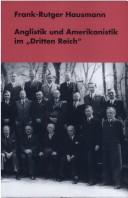| Listing 1 - 8 of 8 |
Sort by
|
Book
Year: 2003 Publisher: National Bureau of Economic Research
Abstract | Keywords | Export | Availability | Bookmark
 Loading...
Loading...Choose an application
- Reference Manager
- EndNote
- RefWorks (Direct export to RefWorks)

ISBN: 3465032306 Year: 2003 Publisher: Frankfurt am Main Klostermann
Abstract | Keywords | Export | Availability | Bookmark
 Loading...
Loading...Choose an application
- Reference Manager
- EndNote
- RefWorks (Direct export to RefWorks)
American literature --- English philology --- Study and teaching --- History --- Great Britain --- United States --- Civilization
Book
ISBN: 3933096979 Year: 2003 Publisher: Nürnberg Verlag für moderne Kunst
Abstract | Keywords | Export | Availability | Bookmark
 Loading...
Loading...Choose an application
- Reference Manager
- EndNote
- RefWorks (Direct export to RefWorks)
Art --- installations [visual works] --- multimedia works --- art [discipline] --- light art --- DVDs --- Gramsma, Bob --- Switzerland
Digital
Year: 2003 Publisher: Cambridge, Mass. NBER
Abstract | Keywords | Export | Availability | Bookmark
 Loading...
Loading...Choose an application
- Reference Manager
- EndNote
- RefWorks (Direct export to RefWorks)
Book
ISBN: 3510652096 Year: 2003 Publisher: Stuttgart : E. Schweizerbart,
Abstract | Keywords | Export | Availability | Bookmark
 Loading...
Loading...Choose an application
- Reference Manager
- EndNote
- RefWorks (Direct export to RefWorks)
Book
ISBN: 3510652088 Year: 2003 Publisher: Berlin : Schweizerbart
Abstract | Keywords | Export | Availability | Bookmark
 Loading...
Loading...Choose an application
- Reference Manager
- EndNote
- RefWorks (Direct export to RefWorks)
593.1 --- 575.86 --- 591.1 --- 591.5 --- 577.2 --- Protozoa. Protists --- Origin of groups of organisms (taxa). Phylogeny --- Animal physiology --- Animal habits. Animal behaviour. Ecology. Ethology. Animal and environment. Bionomy --- Molecular bases of life. Molecular biology --- GBZ General Biology, Zoology & Biophilosophy --- Protista --- general biology and zoology --- protistology --- 577.2 Molecular bases of life. Molecular biology --- 591.5 Animal habits. Animal behaviour. Ecology. Ethology. Animal and environment. Bionomy --- 591.1 Animal physiology --- 575.86 Origin of groups of organisms (taxa). Phylogeny --- 593.1 Protozoa. Protists
Book
Year: 2003 Publisher: Cambridge, Mass. National Bureau of Economic Research
Abstract | Keywords | Export | Availability | Bookmark
 Loading...
Loading...Choose an application
- Reference Manager
- EndNote
- RefWorks (Direct export to RefWorks)
The existence of a natural resource curse has been a longstanding theme in the economic literature and in policy discussions. We propose an alternative mechanism and study its policy implications. The mechanism is based on the interaction between two building blocks: specialization in non-tradables and financial market imperfections. We show that if a country has a sufficiently large non-resource tradable sector, relative prices can be stable, even when the resource sector generates significant volatility in the demand for non-tradables. However, when the non-resource tradable sector disappears, the economy becomes much more volatile, because shocks to the demand for non-tradables - possibly associated with shocks to resource income - will not be accommodated by movements in the allocation of labor but instead by expenditure-switching. This requires much higher relative price movements. The presence of bankruptcy costs makes interest rates dependent on relative price volatility. These two effects interact causing the economy to specialize inefficiently away from non-resource tradables: the less it produces of them, the greater the volatility of relative prices, the higher the interest rate the sector faces, causing it to shrink even further until it disappears. At that point, the economy will face an even higher interest rate and a lower level of capital and output in the non-tradable sector. An increase in resource income that leads to specialization causes a large decline in welfare: thus the idea of the curse. Specialization is determined by the expected size and volatility in resource income. The paper justifies stabilization and savings policies as well as policies to make financial markets more efficient. However, we also find some support for more interventionist second-best trade and financial
Book
Year: 2003 Publisher: Cambridge, Mass. National Bureau of Economic Research
Abstract | Keywords | Export | Availability | Bookmark
 Loading...
Loading...Choose an application
- Reference Manager
- EndNote
- RefWorks (Direct export to RefWorks)
Recent years have seen the development of a large literature on balance sheet factors in emerging-market financial crises. In this paper we discuss three concepts widely used in this literature. Two of them original sin' and debt intolerance' seek to explain the same phenomenon, namely, the volatility of emerging-market economies and the difficulty these countries have in servicing and repaying their debts. The debt-intolerance school traces the problem to institutional weaknesses of emerging-market economies that lead to weak and unreliable policies, while the original-sin school traces the problem instead to the structure of global portfolios and international financial markets. The literature on currency mismatches, in contrast, is concerned with the consequences of these problems and with how they are managed by the macroeconomic and financial authorities. Thus, the hypotheses and problems to which these three terms refer are analytically distinct. The tendency to use them synonymously has been an unnecessary source of confusion.
| Listing 1 - 8 of 8 |
Sort by
|

 Search
Search Feedback
Feedback About UniCat
About UniCat  Help
Help News
News